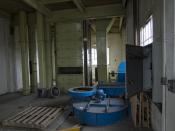Eavan Boland's poem "The Necessity for Irony" begins in narrative tone, when on a unremarkable Sunday Eavan, with her daughter, go browsing for antiques in town. However, by the end of the poem, Eavan's tone is lyrical, as she sends an apostrophe to the "spirit of irony," asking it to "reproach" her for focusing on antiques rather than what was truly beautiful, her child. Her dramatic shift in tone is slow and accomplished using various techniques.
In the first stanza of "The Necessity for Irony," Eavan begins to build the antique shopping scene:
"On Sundays,
when the rain held off,
after lunch or later,
I would go with my twelve year old
daughter into town,
and put down the time
at junk sales, antique fairs." (1-7)
The beginning of the poem is narrative; Boland crafts an image, each line adding an additional detail, of the Sunday she plans to spend antique shopping with her daughter.
The stanza's tone is emotionless and only gives details to Boland's routine. Also, this stanza is one long sentence; when it is read, the tone is simply descriptive, and each line lacks emphasis and powerful feeling. Boland focuses this stanza on description of the setting.
In the second stanza Boland continues to describe the setting, and introduces her daughter:
There I would
lean over tables,
absorbed by
place, wooden frames,
glass. My daughter stood
at the other end of the room,
her flame-coloured hair
obvious whenever--
which was not often-- " (8-16)
Boland says it explicitly: she was "absorbed by / place, wooden frames, / glass." Boland is absorbed by the antique-place, and ignores her daughter, who is in a different place, "at the other end of the room." Here Boland introduces the physical distance between her and daughter, caused by Boland's interest and...


